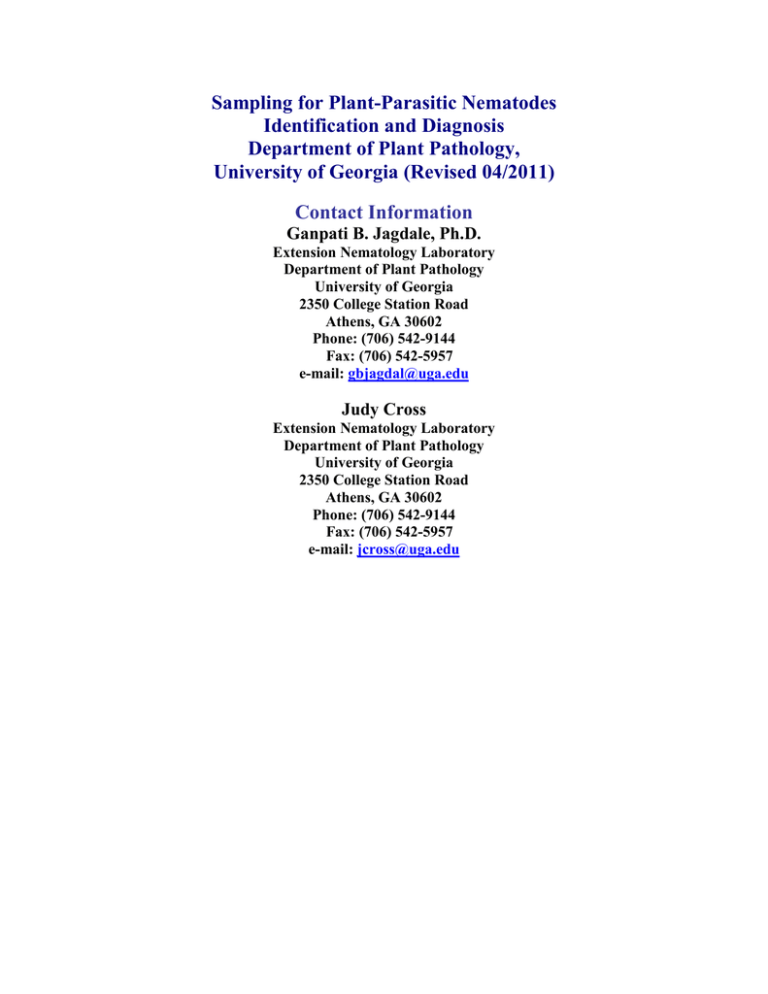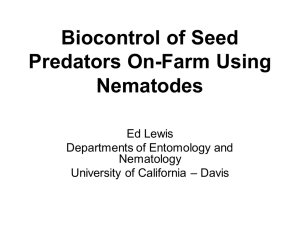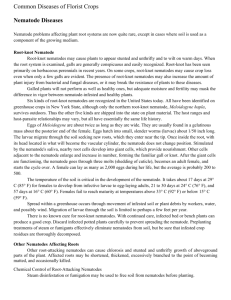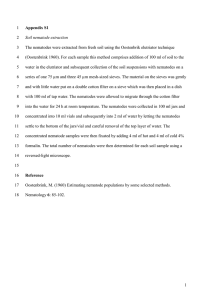Sampling for Plant-Parasitic Nematodes Identification and Diagnosis Department of Plant Pathology,
advertisement

Sampling for Plant-Parasitic Nematodes Identification and Diagnosis Department of Plant Pathology, University of Georgia (Revised 04/2011) Contact Information Ganpati B. Jagdale, Ph.D. Extension Nematology Laboratory Department of Plant Pathology University of Georgia 2350 College Station Road Athens, GA 30602 Phone: (706) 542-9144 Fax: (706) 542-5957 e-mail: gbjagdal@uga.edu Judy Cross Extension Nematology Laboratory Department of Plant Pathology University of Georgia 2350 College Station Road Athens, GA 30602 Phone: (706) 542-9144 Fax: (706) 542-5957 e-mail: jcross@uga.edu A QUICK GUIDE TO SAMPLING FOR NEMATODES By Ganpati Jagdale WHAT ARE NEMATODES? Nematodes are thread-like microscopic worms that live in all habitats especially soil and water. Most species are beneficial but some are harmful parasites of plants and animals. WHAT ARE PLANT-PARASITIC NEMATODES? Plant-parasitic nematodes are characterized by having a needle like structure in the mouth called a stylet that depending on the nematode species is used to feed on plant parts that may include roots, stems, leaves and seeds. WHY ARE PLANT-PARASITIC NEMATODES IMPORTANT? Plant-parasitic nematodes can cause a significant economic damage to almost all vegetable and field crops, fruit trees, ornamentals and turfgrass by reducing both yield and quality. Annual global yield loss caused by nematodes is $78- 80 billion with an estimated annual losses in the US of $8 billion. Damage caused by nematodes may provide an infection site for other disease causing pathogens that may cause additional loss in crop quality and yield. WHAT DOES DAMAGE BY PLANT-PARASITIC NEMATODES LOOK LIKE? Damage caused by plant-parasitic nematodes can initially appear as nutrient deficiency in the foliage and therefore is often incorrectly diagnosed. As root damage is a common due to feeding by plant-parasitic nematodes, nutrients and water essential for proper plant growth may not be absorbed. HOW ARE PLANT-PARASITIC NEMATODES MANAGED? Detection and correct identification of nematode species is the first step in managing plant-parasitic nematodes to check their spread and prevent economic damage. As most plant-parasitic nematodes live in the soil associated with plant roots, timely sampling of soil and plant samples is an important step in implementing appropriate strategies for control and preventing economic damage. The specific strategy for managing plant-parasitic nematodes varies with the crop. HOW TO SAMPLE: Timing: The timing of nematode sampling is important because nematode populations fluctuate throughout the year. Nematodes may be undetectable during the winter and early spring but often increase to a very high population density in the early fall before crop harvest when living roots are present. After harvest, nematode population may decline sharply. Thus, taking samples at the appropriate time for a crop decreases the risk of failing to detect a damaging nematode species and helps avoid or reduce the potential of nematode problems in the future. Sampling in the early fall facilitates decision making in implementing appropriate nematode management practices before the next crop is planted. The optimum time to take samples for nematode assay from various Georgia crops is given below: Crop When to sample Cotton Peaches and other fruit orchards Peanuts Soybeans Tobacco Warm season turfgrass Oct. and Nov. Feb.to Apr and Sept. to Oct. Sept. to Oct. Sept. to Nov. July Jun. to Aug. Cool season turfgrass Vegetables Sept. to Oct. Aug. to Sept. Sampling depth in inches (cm) 8 inches (20) 8 inches (20) Common Nematodes 8 inches (20) 8 inches (20) 8 inches (20) 6 inches (15) Root-knot Lance, Reniform, Root-knot, Cyst Root-knot Lance, Reniform, Root-knot, Sting 6 inches (15) 8 inches (20) Lance, Reniform, Root-knot, Sting Root-knot Lance, Reniform, Root-knot Root-knot WHAT AND WHERE TO SAMPLE: In the field nematode distribution is always patchy because their population density is often affected by the crop grown, presence of weed hosts, chemicals used and environmental factors. Because of the patchy distribution of nematodes, it is very important that the soil sample be truly representative of the area sampled. The only way to ensure the sample is representative is to collect soil from many spots around the field rather than from only one or two spots. Soil samples should only be collected when soil moisture is suitable for working the field. Avoid sampling under excessively dry, wet or frozen soil conditions. Soil samples should be taken from around the plant root (rhizosphere). Sampling depth may differ for different crops (see above Table). In the fallow field, samples should be taken from the depth of the root zone of the future crop. For fields left fallow, or fields under dry or frozen conditions for a long period of time, the depth of sampling should be more than 30 inches. In cases where there may be infection of the plant by a nematode, plant samples should be collected from plant parts (leaves, stems, bulbs, tubers or roots) that are suspected or showing symptoms of nematode infection. Both soil and plant samples should be taken from areas showing nematode damage (symptoms) and from healthy areas for comparison. If a problem area is being sampled, collect soil from the margin of the affected area to ensure presence of high nematode population (Fig. 1). Even if a small problem area is being sampled, soil should still be collected from multiple spots within the area being sampled. If a very large area (> 5 acres) is sampled, high-population density areas will be diluted by low population density areas so that areas with nematode problems will be more difficult to identify. Therefore, one composite soil sample should be taken for every 4 to 5 acres. The sample may represent a section that has homogeneous soil type and conditions and is uniformly farmed. The shape of a field may influence the number of acres that a sample represents. Figure 1 HOW TO SAMPLE: Properly taken samples from small field units can reduce production costs by allowing the grower to eliminate nematode control practices where they are not needed and implement control practices where they are needed. Improper sampling can lead to poor recommendations and economic losses which could have been avoided. Both large areas (fields, golf course fairways and rough areas) and small areas (home lawns, recreational parks and golf course greens) should be sampled in a systemic, zigzag pattern (Fig. 2A and 2B). Figure 2A Figure 2B As nematodes may not survive in upper 1-2 inches of soil due to extreme environmental conditions (hot and cold), first remove upper soil layer and then take samples using a 2.5cm (1-inch) diameter soil probe (Fig. 3). Figure 3 Take 20-30 soil cores in a zigzag pattern from regularly spaced locations throughout a large area (4-5 acre section) or a small area (≤ 1.25 acres [≤5000 m2]). Single plants such as fruit trees and ornamental shrubs should be sampled under the canopy drip line (Fig. 4) The number of soil cores taken will depend on the size of tree/shrub canopy. For example, about 8 soil cores should be collected for 10ft diameter canopy and about 12 soil cores for15 ft diameter canopy. Collected soil cores should be thoroughly mixed into one composite sample. From each thoroughly mixed composite sample about 1 pint (1/2 liter) of soil Figure 4 should be transferred into a labeled plastic bag for nematode assay. HANDLING OF SOIL SAMPLES FOR NEMATODE ASSAY: Improper handling of samples can lead to poor estimation of the nematode population, which in turn could lead to a wrong recommendation. Nematodes must be alive for the extraction procedure. Do not allow samples to sit in direct sunlight in the field or in a hot vehicle for even a short time. Excessive heat or drying can kill the nematodes in the sample which will result in failure to detect nematodes in the sample. During transit, samples should be stored in an insulated cooler to avoid getting them hot or dry. Once in the laboratory, samples can be stored in a refrigerator until they are processed for nematode extraction. LABELING OF SOIL SAMPLES FOR NEMATODE ASSAY: Always label plastic bags on the outside with a permanent marker. Label should include sample name/number, location and date of sampling. Each sample should be accompanied with a completed NEMATODE ASSAY FORM, which can be downloaded from http://www.iiseyes.org/nars/ Provide all information requested. The information on this form will determine the usefulness of the resulting recommendations. List present, past, and future crop to assist in identifying nematode problems and making management recommendations. Also list crop variety grown. Variety information is critical for many crops. SHIPPING OF SOIL SAMPLES FOR NEMATODE ASSAY: Deliver in person or mail sample using any express delivery service (FedEx or UPS, US post service etc.). Send samples early in the week so that they do not spend the weekend in transit. Samples for nematode assay should be submitted through your local county Extension office. Your county Extension Office will send the samples to the Extension Nematology Laboratory. The Sender is responsible for all shipping expenses. Mailing Address: Extension Nematology Laboratory, Department of Plant Pathology 2350 College Station Road, Athens, GA 30602 WHEN YOU OBTAIN THE RESULTS: The results of the assay and management recommendations will be returned to you through your county Extension office within 4-5 days after receipt of samples. Keep a record of which nematodes are found in which fields. OTHER RESOURCES: The following information is available at: http://www.plant.uga.edu/Extension/Clinics/PDC.htm Information about specific nematodes Nematode Summary Report Techniques used for extraction of nematodes: Centrifugation technique for extraction of nematodes from soil. Misting chamber/shaker technique for extraction of nematodes from roots. CHARGES AND FEES: $12.00 = All nematode samples submitted through GA County Extension Office. Please provide name of the County of origination and name of Agent as indicated on the form. Results will be submitted to respective County Office and e-mailed to each client. $12.00 = Samples from UGA research or demonstration projects and Georgia Department of Agriculture. Charge for UGA research samples will be handled by internal billing to UGA accounts/numbers. $25.00 = All instate nematode samples not submitted via GA County Office. $25.00 = All nematode samples submitted from out of state. $35.00 = Identification of root-knot nematode species using PhastSystem. Request for root-knot nematode speciation must be made by either County or State UGA faculty to the Extension Nematology Lab Manager prior to sample submission (Call to arrange payment at 706-542-9144). $45.00 = Identification of free-living nematodes at genus level (Call to arrange payment at 706-542-9144). Nematode disease diagnosis Ganpati B. Jagdale Extension Nematology Laboratory Department of Plant Pathology University of Georgia 2350 College Station Rd. Athens, GA 30602 Administrative and related issues Dr. John L. Sherwood Department of Plant Pathology University of Georgia 2105 Miller Plant Science Building Athens, GA 30602-7274 Phone: 706-542-9144 Fax: 706-542-5957 gbjagdal@uga.edu Phone: 706-542-1246 Fax: 706-542-1262 sherwood@uga.edu







